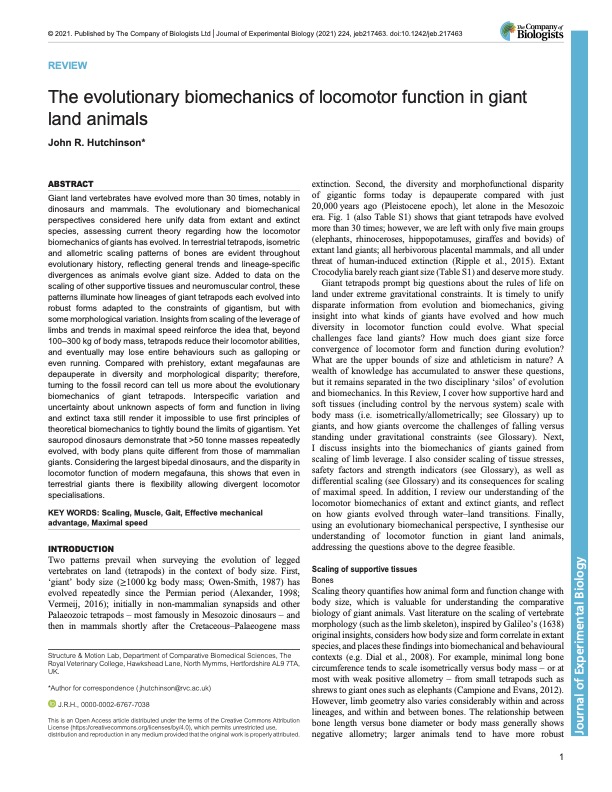John Hutchinson
The evolutionary biomechanics of locomotor function in giant land animals
Hutchinson, John
Authors
Abstract
Giant land vertebrates have evolved more than 30 times, notably in dinosaurs and mammals. The evolutionary and biomechanical perspectives considered here unify data from extant and extinct species, assessing current theory regarding how the locomotor biomechanics of giants has evolved. In terrestrial tetrapods, isometric and allometric scaling patterns of bones are evident throughout evolutionary history, reflecting general trends and lineage-specific divergences as animals evolve giant size. Added to data on the scaling of other supportive tissues and neuromuscular control, these patterns illuminate how lineages of giant tetrapods each evolved into robust forms adapted to the constraints of gigantism, but with some morphological variation. Insights from scaling of the leverage of limbs and trends in maximal speed reinforce the idea that, beyond 100–300 kg of body mass, tetrapods reduce their locomotor abilities, and eventually may lose entire behaviours such as galloping or even running. Compared with prehistory, extant megafaunas are depauperate in diversity and morphological disparity; therefore, turning to the fossil record can tell us more about the evolutionary biomechanics of giant tetrapods. Interspecific variation and uncertainty about unknown aspects of form and function in living and extinct taxa still render it impossible to use first principles of theoretical biomechanics to tightly bound the limits of gigantism. Yet sauropod dinosaurs demonstrate that >50 tonne masses repeatedly evolved, with body plans quite different from those of mammalian giants. Considering the largest bipedal dinosaurs, and the disparity in locomotor function of modern megafauna, this shows that even in terrestrial giants there is flexibility allowing divergent locomotor specialisations.
Citation
Hutchinson, J. (2021). The evolutionary biomechanics of locomotor function in giant land animals. Journal of Experimental Biology, https://doi.org/10.1242/jeb.217463
| Journal Article Type | Review |
|---|---|
| Acceptance Date | Apr 29, 2021 |
| Publication Date | Jun 8, 2021 |
| Deposit Date | Apr 14, 2021 |
| Publicly Available Date | Jun 21, 2021 |
| Journal | Journal of Experimental Biology |
| Print ISSN | 0022-0949 |
| Electronic ISSN | 1477-9145 |
| Publisher | The Company of Biologists |
| Peer Reviewed | Peer Reviewed |
| DOI | https://doi.org/10.1242/jeb.217463 |
| Public URL | https://rvc-repository.worktribe.com/output/1443512 |
Files
OA
(212 Kb)
Image
Publisher Licence URL
http://creativecommons.org/licenses/by/4.0/
You might also like
The evolution of femoral morphology in giant non-avian theropod dinosaurs
(2024)
Journal Article
Estimation of the forces exerted on the limb long bones of a White Rhinoceros
(2024)
Journal Article
Downloadable Citations
About RVC Repository
Administrator e-mail: publicationsrepos@rvc.ac.uk
This application uses the following open-source libraries:
SheetJS Community Edition
Apache License Version 2.0 (http://www.apache.org/licenses/)
PDF.js
Apache License Version 2.0 (http://www.apache.org/licenses/)
Font Awesome
SIL OFL 1.1 (http://scripts.sil.org/OFL)
MIT License (http://opensource.org/licenses/mit-license.html)
CC BY 3.0 ( http://creativecommons.org/licenses/by/3.0/)
Powered by Worktribe © 2025
Advanced Search

